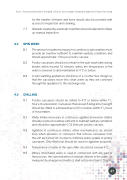Part 2 | Processing Procedures Designed to Ensure an Acceptable Standard of Hygiene in Poultry Processing for the transfer of hearts and livers should also be provided with access for inspection and cleaning. 7.7 Gizzards cleaned by automatic machines should subjected to follow up manual inspection. 8.0 SPIN WASH 8.1 The amount of water necessary in a continuous spin washers must provide an over ow suf cient to maintain sanitary conditions and should approximate 1 litre per poultry carcass. 8.2 Poultry carcasses should not remain in the spin wash tank during breaks which exceed 15 minutes unless the temperature of the water is lowered to and maintained at 4°C or below. 8.3 A spin washing appliances should be of a counter ow design so that the carcasses move into clean water as they are conveyed through the appliance to the discharge end. 9.0 CHILLING 9.1 Poultry carcasses should be chilled to 4oC or below within 11/2 hours of evisceration. Carcasses that exceed 5 kilograms in weight should be chilled to a temperature of 4oC or below, within 21/2 hours of evisceration. 9.2 Water intake necessary in continuous agitated immersion chillers should provide an over ow suf cient to maintain sanitary conditions and should be approximate 0.75 litres per poultry carcass. 9.3 Agitation in continuous chillers, either mechanical or air, should stop when elevators or conveyors that remove carcasses from the unit are turned off, in order to minimise water uptake of poultry carcasses. Only ltered air should be used for agitation purposes. 9.4 Temperature of water in the spin chiller should not exceed 4oC. 9.5 Where chlorinated water is used in connection with any part of the process, the concentration of residual chlorine in the water, as measured by an approved method, shall not be less than 0.25ppm. 47
